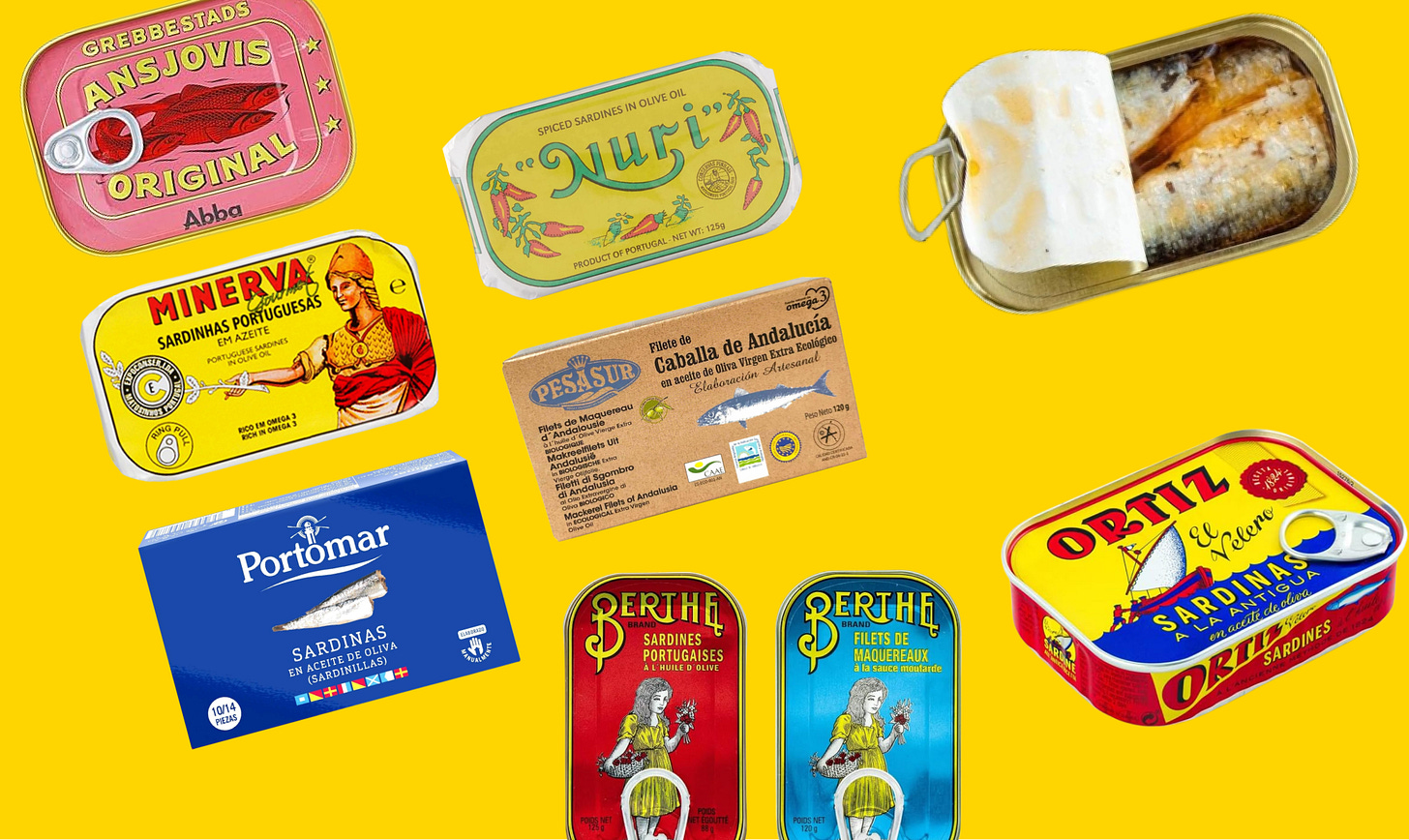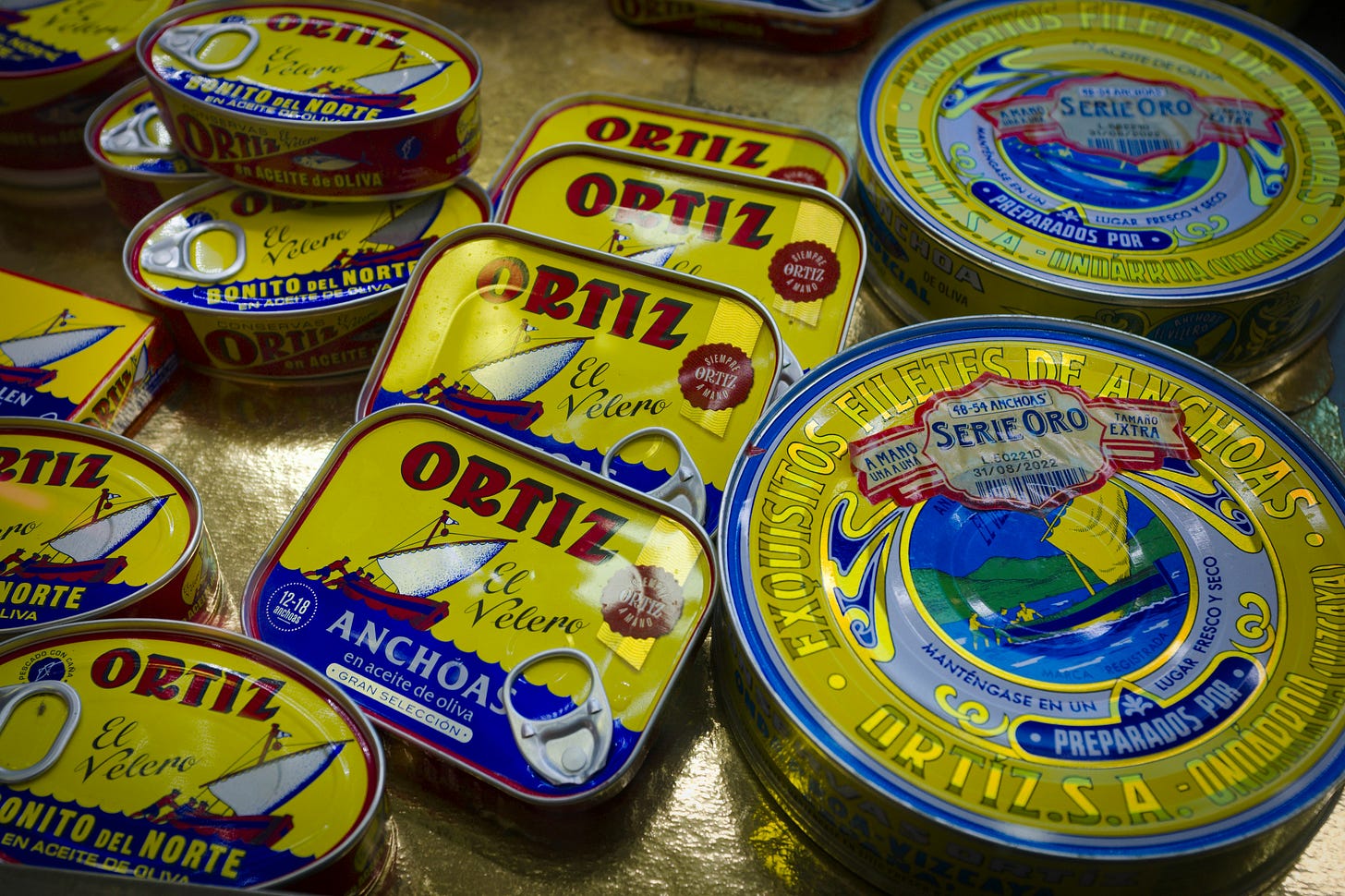Picture this: you’re at a dinner party, white wine in hand, and the host is proudly gesturing to their countertop where Ortiz tins sit like miniature Fabergé eggs.
“Ah, the good stuff” someone says, as if we weren’t talking about sardines. But here we are, tinned fish has become a status symbol, rubbing shoulders with posh olive oil and Himalayan salt in the middle class pantry parade.
Once the humblest of staples, tinned fish has undergone a glow-up so dramatic it might as well have its own Instagram account. According to Waitrose’s annual food and drink report, sales of premium pantry items, think £6 tins of sardines and £25 bottles of olive oil, are through the roof.
The trend is a bigger cultural phenomenon: we’re curating our cupboards as much as our wardrobes and we’re not afraid to pay for it.
So how did this happen? How did the tin of pilchards your nan kept at the back of the cupboard become a golden ticket status symbol? Let’s open the tin and find out.
The Early Days
Tinned fish wasn’t always the star of the middle class dinner party. It all started with the rather unglamorous aim of feeding armies. In the early 19th century Napoleon Bonaparte offered a cash prize to anyone who could come up with a way of preserving food for his troops, a necessity for soldiers on long campaigns.
The winner was Nicolas Appert who came up with the idea of sealing food in glass jars but it was British inventor Peter Durand who patented the use of tin containers in 1810 and that’s how the canned food industry was born.
For most of the 19th and early 20th centuries tinned fish was survival food. Sardines, mackerel and pilchards were put in tins not for looks but for practicality. It was cheap, portable and lasted forever, or at least long enough to get sailors, miners and soldiers through a long day’s work. John West and other big brands made it a household staple in the 20th century, an affordable source of protein that didn’t require refrigeration.
The tin of fish was democratic, it fed both the working class and explorers trekking to the poles. While tins of herring kept Scandinavian fishermen fed, explorers like Ernest Shackleton relied on canned provisions to survive in the Antarctic. It wasn’t glamorous but it got the job done.
For years a tin of sardines was as common as a loaf of bread. Far from the designer tins of today that glint like treasure. But as history proves the humblest of foods can have the most surprising makeovers.
From Survival Food to Culinary Chic
From utility food to culinary star, the transformation is nothing short of amazing. Once the domain of wartime pantries and frugal suppers, its fortunes changed in the latter half of the 20th century with the rise of Mediterranean cuisine.
Suddenly sardines and anchovies weren’t just staples; they were symbols of a sun-kissed life, cobbled streets, seaside trattorias and slow lunches under olive trees.
Enter the 21st century food revolution where provenance was king. Artisanal producers emerged, touting hand packed sardines in first-press olive oil and sustainably caught mackerel in tins so beautiful they could be hung on your wall. Brands like Spain’s Ortiz and Portugal’s José Gourmet turned what was once an anonymous tin into an art form, each can a tiny edible luxury.
Chefs and influencers were quick to jump on the bandwagon. Sardines on toast, once the epitome of austerity, were reimagined as a chic appetizer, especially when served with sourdough and olive oil that cost more than a bottle of prosecco. Smoked sprats and ventresca tuna found their way into glossy magazines and Instagram feeds, flaunting their brightly coloured tins like designer handbags.
Social media played its part in tinned fish becoming an icon. The design of a tin from Conservas La Gondola or Fangst isn’t by accident; these brands know we eat with our eyes first.
Add to that the focus on sustainability and you have the perfect storm for tinned fish to rise to the top of the culinary ladder. Today cracking open a tin of posh sardines feels less like a shortcut and more like a treat. A little luxury without the guilt.
The Economics of Indulgence
Posh tinned fish isn’t cheap. A tin of Ortiz sardines will cost you about £6, while the budget equivalent will cost you less than a quid. The maths might make your eyes water but the economics of indulgence isn’t about practicality; it’s about perception. In an age where many can’t afford fancy holidays or nights out, the pantry has become the more accessible luxury canvas.
This is what marketers call “affordable luxuries”. Unlike a trip to the Maldives, a tin of premium mackerel feels like a treat you can justify. It’s not just food. It’s an experience.
You’re paying for the story: the sustainably caught fish, the extra-virgin olive oil, the hand-packing process and of course the beautiful tin you’ll proudly display in your recycling bin for weeks.
But there’s more to this. As the cost of living has tightened household budgets, people have changed their spending habits. Instead of splurging on big ticket items, they’re looking for smaller indulgences to brighten up the everyday.
A £6 tin of sardines is a moment of escapism, a chance to feel fancy without breaking the bank. It’s the same logic that has us sipping £4.65 oat milk lattes while wearing last season’s coat.
And let’s not forget the power of branding. These tins are deliberately designed to tap into middle-class anxieties around food, sustainability, provenance and being in the know. Buying Ortiz isn’t just about the taste; it’s what the tin says about you. It tells you you’re a discerning shopper, a connoisseur of the good life, even if your overdraft disagrees.
Why We Love Tinned Fish Today
For starters, it ticks all the modern foodie boxes: sustainability, convenience, and versatility. It’s fish without the faff—a quick twist of the tin key and you’re halfway to a meal that feels like you’re on the continent. No scales, no smell, no guilt about overfished oceans (as long as you’re buying responsibly sourced, of course).
Then there’s the flavour. Sardines in golden olive oil, smoked trout in a rich tomato sauce, mackerel fillets with a squeeze of lemon, all bursting with briny, savoury goodness. Tinned fish doesn’t just taste good; it tastes like a holiday. A bite of ventresca tuna can transport you to a seaside café in San Sebastián in a mouthful.
Layer Ortiz anchovies over fresh butter and sourdough for a simple yet indulgent snack, or toss mackerel fillets through pasta with garlic, chilli and parsley for a dinner that feels like more effort than it is. Whether you’re assembling a nibbles board or padding out a salad, tinned fish has become the foodie’s best friend: a shortcut ingredient that sacrifices nothing in flavour or sophistication.
But perhaps the real reason we love it is its ease. Fancy without being fussy, indulgent yet unpretentious, posh tinned fish is the perfect antidote to the modern kitchen’s demands. You don’t need hours of prep or a Michelin star to open a tin, spread its contents on toast and feel like you’ve cooked dinner. It’s an everyday luxury, simple, satisfying and a little bit aspirational.
Conclusion: A Sardine in a Gold Tin
Posh tinned fish is a sign of our changing relationship with food. What was once a thrifty staple has been polished into a middle class status symbol. It’s a curious kind of luxury – affordable yet indulgent, nostalgic yet trendy and every bit as much about the story on the tin as the fish inside.
But this is more than just clever branding. It’s a reflection of broader cultural shifts: our move towards sustainability, our love of small everyday luxuries and our love of foods that make us feel connected to something bigger, a Mediterranean holiday or a movement towards mindful eating.
In the end, posh tinned fish is a reminder that luxury doesn’t have to come with a hefty price tag or a side of guilt. It can be as simple as a nice tin, a drizzle of olive oil and the satisfaction of turning a humble sardine into something truly fabulous.






